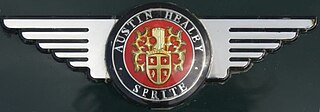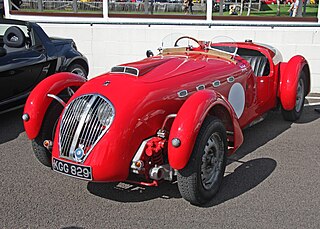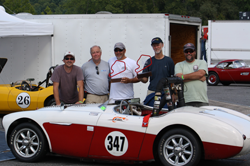
The Austin Motor Company Limited was an English manufacturer of motor vehicles, founded in 1905 by Herbert Austin in Longbridge. In 1952 it was merged with Morris Motors Limited in the new holding company British Motor Corporation (BMC) Limited, keeping its separate identity. The marque Austin was used until 1987. The trademark is currently owned by the Chinese firm SAIC Motor, after being transferred from bankrupt subsidiary Nanjing Automotive which had acquired it with MG Rover Group in July 2005.

The Austin-Healey Sprite is a small open sports car produced in the United Kingdom from 1958 until 1971. The Sprite was announced to the press in Monte Carlo by the British Motor Corporation on 20 May 1958, two days after that year's Monaco Grand Prix. It was intended to be a low-cost model that "a chap could keep in his bike shed", yet be the successor to the sporting versions of the pre-war Austin Seven. The Sprite was designed by the Donald Healey Motor Company, with production being undertaken at the MG factory at Abingdon. It first went on sale at a price of £669, using a tuned version of the Austin A-Series engine and as many other components from existing cars as possible to keep costs down.
Donald Mitchell Healey CBE was a noted English car designer, rally driver and speed record holder.
Austin-Healey was a British sports car maker established in 1952 through a joint venture between the Austin division of the British Motor Corporation (BMC) and the Donald Healey Motor Company (Healey), a renowned automotive engineering and design firm. Leonard Lord represented BMC and Donald Healey his firm.

Donald Healey Motor Company Limited was a British car manufacturer.

Longbridge plant is an industrial complex in Longbridge, Birmingham, England, currently leased by SAIC as a research and development facility for its MG Motor subsidiary. Vehicle assembly ended in 2016.

The Austin-Healey 3000 is a British sports car built from 1959 until 1967. It is the best known of the "big Healey" models. The car's bodywork was made by Jensen Motors and the vehicles were assembled at BMC's MG Works in Abingdon, alongside the corporation's MG models.

Jensen Motors Limited was a British manufacturer of sports cars and commercial vehicles in West Bromwich, England. Brothers Alan and Richard Jensen gave the new name, Jensen Motors Limited, to the commercial body and sports car body making business of W J Smith & Sons Limited in 1934. It ceased trading in 1976. Though trading resumed in 1998, Jensen Motors Limited was dissolved in 2011.

The Morgan 4/4 is a British motor car which was produced by the Morgan Motor Company from 1936 to 2018. It was Morgan's first car with four wheels, the name indicating that the model has four wheels and four cylinders. Early publicity and advertising material variously referred to the model as "4/4", "4-4", "Four Four", and similar names, but from the outset the factory designation was always "4/4".

The MGA is a sports car that was produced by MG from 1955 until 1962.

The BMC C-Series is a straight-6 automobile engine produced from 1954 to 1971. Unlike the Austin-designed A-Series and B-Series engines, it came from the Morris Engines drawing office in Coventry and therefore differed significantly in its layout and design from the two other designs which were closely related. This was due to the C-Series being in essence an enlarged overhead valve development of the earlier 2.2 L Straight-6 overhead camshaft engine used in the post-war Morris Six MS and Wolseley 6/80 from 1948 until 1954, which itself also formed the basis of a related 1.5 L 4-cylinder engine for the Morris Oxford MO in side-valve form and the Wolseley 4/50 in overhead camshaft form. Displacement was 2.6 to 2.9 L with an undersquare stroke of 88.9 mm (3.50 in), bored out to increase capacity.

The Austin A90 Atlantic is a British car produced by the Austin Motor Company from 1949 until 1952. It was launched initially as a four-seat convertible, making its début at the 1948 Earls Court Motor Show in London, with production models built between early 1949 and late 1950. A two-door coupé, marketed as the A90 Atlantic sports saloon, followed a year later. It had been previewed at the 1949 Motor Show and was in production at Longbridge between 1950 and 1952.

The A40 Devon are automobiles that were marketed by Austin from 1947 to 1952 – the first post-war saloons to be produced by Austin – featuring a mix of old and new technologies. They were previewed by the UK press at the Paris Motor Show on 22 October 1947, who expressed immediate disappointment at the car's conservative appearance. More than 450,000 were built before the model's replacement in 1952 by the Austin A40 Somerset.

The Austin Westminster series are large saloon and estate cars that were sold by the British manufacturer Austin from 1954, replacing the A70 Hereford. The Westminster line was produced as the A90, A95, A99, A105, and A110 until 1968 when the new Austin 3-Litre took its place. Essentially badge-engineered versions of the Farina Westminsters were also produced using the premium Wolseley and Vanden Plas marques. 101,634 Westminsters were built.

The Austin 7 is an economy car that was produced from 1923 until 1939 in the United Kingdom by Austin. It was nicknamed the "Baby Austin" and was at that time one of the most popular cars produced for the British market and sold well abroad. Its effect on the British market was similar to that of the Model T Ford in the US, replacing most other British economy cars and cyclecars of the early 1920s. It was also licensed and copied by companies all over the world. The first BMW car, the BMW Dixi, was a licensed Austin 7. In France they were made and sold as Rosengarts, and in the United States they were built by the American Austin Car Company. In Japan, Nissan also used the 7 design as the basis for their first cars, although not under licence. This eventually led to a 1952 agreement for Nissan to build and sell Austins in Japan under the Austin name.

The Rolls-Royce 15 hp was one of four cars to be produced as a result of an agreement of 23 December 1904 between Charles Rolls and Henry Royce. Badged as a Rolls-Royce, the 15 hp was produced by Royce's company, Royce Ltd., at its factory in Cooke Street, Hulme, Manchester. It was sold exclusively by Rolls' motor dealership, C.S.Rolls & Co., at a price of GBP500. The 15 hp was exhibited at the Paris Salon in December 1904, along with the 10 hp, 20 hp and engine for the 30 hp models, but as the new three-cylinder engine was not ready the chassis was incomplete.

The Austin-Healey 100-6 is a two-seat roadster that was announced in late September 1956 and produced from 1956 until 1959. A replacement for the Austin-Healey 100, it was followed by the Austin-Healey 3000; together, the three models have become known as the Big Healeys.

The Austin 40 hp is a 4-cylinder motor car launched at the Olympia Motor Show in November 1907. Manufactured by Austin at Longbridge, Northfield, Birmingham, it was the first variant from Austin's initial plans for a two model range of a 15 hp —which they had dropped—and a 25 hp car.

The Healey Silverstone is an open, two-seat sports car produced by the Donald Healey Motor Company beginning in 1949. It is named for the Silverstone Circuit racetrack, where it appeared on its second competition outing. The car has a narrow roadster style body and cycle wings. Designed as a dual purpose car for both road and track, the Silverstone became popular in club racing.























